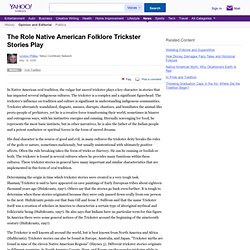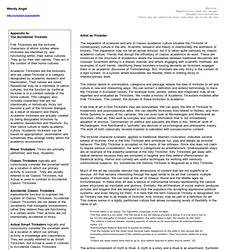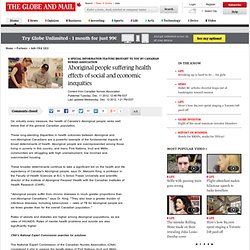

The Role Native American Folklore Trickster Stories Play. In Native American oral tradition, the vulgar but sacred trickster plays a key character in stories that has impacted several indigenous cultures.

The trickster is a complex and a significant figurehead. The trickster's influence on tradition and culture is significant in understanding indigenous communities. Trickster alternately scandalized, disgusts, amuses, disrupts, chastises, and humiliates the animal-like proto-people of prehistory, yet he is a creative force transforming their world, sometimes in bizarre and outrageous ways, with his instinctive energies and cunning. Eternally scavenging for food, he represents the most basic instincts, but in other narratives, he is also the father of the Indian people and a potent conductor or spiritual forces in the form of sacred dreams.
Determining the origin in time which trickster stories were created is a very tough task. The Trickster is well known all around the world, but is best known from North America and Africa (Hultkrantz). Artist as Trickster by Wendy Angel. Artist as Trickster The separation of sciences and arts in classic academic culture situates the Trickster of contemporary culture in the arts.

Scientific research and theory is intentionally the antithesis of trickery. This separation may not be an actual division, but it is taken quite seriously by classic academic culture. Trends that disrupt the orthodoxy of classic academics do exist. These are instances in the structure of academics where the boundaries between traditional disciplines are crossed. The classic desire to universalize, categorize and package relates the idea of trickster to art and culture in new and interesting ways.
If we look at art to find Tricksters they are everywhere. Anishinaabemowin Medicine Wheel. 4directions. Grandfather teachings. "The Brendan Cross Story" documentary. Four Directions Teachings.com - Aboriginal Online Teachings and Resource Centre - © 2006 - 2012 All Rights Reserved 4D Interactive Inc., a subsidiary of Invert Media Inc. Aboriginal people suffering health effects of social and economic inequities. On virtually every measure, the health of Canada’s Aboriginal people ranks well below that of the general Canadian population.

These long-standing disparities in health outcomes between Aboriginal and non-Aboriginal Canadians are a powerful example of the fundamental impacts of broad determinants of health. Aboriginal people are overrepresented among those living in poverty in this country, and many First Nations, Inuit and Métis communities are struggling with high unemployment, low incomes and overcrowded housing. These broader determinants continue to take a significant toll on the health and life expectancy of Canada’s Aboriginal people, says Dr. Malcolm King, a professor in the Faculty of Health Sciences at B.C.’s Simon Fraser University and scientific director of the Institute of Aboriginal Peoples' Health with the Canadian Institutes of Health Research (CIHR).
“Aboriginal people suffer from chronic diseases in much greater proportions than non-Aboriginal Canadians,” says Dr. Dr. Canada's Relationship with Inuit: A History of Policy and Program Development. Table of Contents Foreword The history of Inuit relations with the Government of Canada has been a story of negotiation, accommodation and resistance. The relationship has developed around a long conversation of rights recognition and struggle for voice within the Canadian political system.
Inuit have made tremendous progress in this, and speak from a position of authority and strength on many issues of concern to them. The conversation and negotiation continues, however, as the story is played out around such issues as control over land and resources, the environment, social programs and the extent and pace of change in the face of maintenance of language, culture and traditional lifestyle.
A significant advance in the struggle for an Inuit political voice was the creation by the Government of Canada of the Inuit Relations Secretariat in 2005. As a result of these initial discussions within INAC, a project was begun that has culminated with the publication of this book.